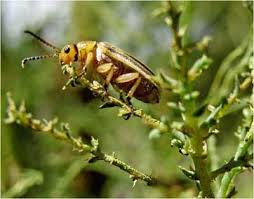
Anyone who hikes or bikes along Colorado waterways has probably seen the impenetrable thickets of a non-native plant called tamarisk, or salt cedar. Clearing out the plant would make way for the return of native foliage like cottonwoods and willows, but scientists have had little luck so far.
At one point, researchers hoped that imported tamarisk-eating beetles would be the magic bullet. The bugs have been doing their job -- sometimes too well. They're so speedy at spreading and voraciously eating tamarisk that they have left cleared areas behind where noxious plants like tumbleweeds and cheat grass crowd in rather than allowing willows and cottonwoods to return. As it turns out, the beetles have also spawned a federal lawsuit.
University of Denver professor Anna Sher Simon studies invasive plant species and has written a book about tamarisk. She told Colorado Matters host Andrea Dukakis about the latest efforts to get rid of the plant.








